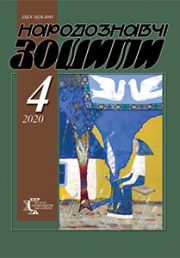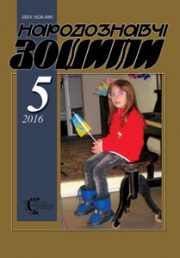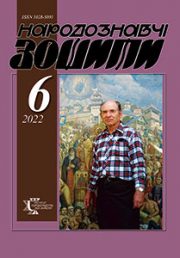The Ethnology Notebooks. 2022. № 4 (166), 918—927
UDK 766.038.532.011
DOI https://doi.org/10.15407/nz2022.04.918
THE BOOK AS AN INTEGRATING PHENOMENON OF ART
RUDENKO Oleh
- ORCID ID: https://orcid.org/0000-0002-2266-8402
- PhD in Art Studies, Associate Professor,
- Ukrainian Academy of Printing,
- Department of Book Graphics and Printmaking,
- 19, Pidholosko str., 79020, Lviv, Ukraine,
- Contacts: e-mail: olehrudenko@gmail.com
Abstract. The article examines the importance of book art for the spiritual, intellectual and aesthetic development of the individual and society. The perception of a book as a work of art has its own individual feature: it is a direct contact between literature and fine arts. With a successful combination, they complement each other, aesthetically reflecting the verbal-image structure of human existence. We underline that the book space is a symbiosis of many genres of art: graphics, painting, and even sculpture, in the form of a three-dimensional block of the publication. Also, the book is a kind of spiritual space of person’s thinking that exists at a certain time and creates an intellectual work of art. An aggressor who wants to eliminate the people, their history and memory, first of all destroys books as ideologically dangerous tools, feared by the greatest tyrants in the world, unless, of course, these books serve their propaganda purposes.
The aim of the article is to show the versatility of the art of the book, which has accumulated the main artistic directions and has expressed them in different ways: visual, tactile, artistic-aesthetic and structural-technological. The book is the most perfect way to communicate in time, to share experiences, achievements and information over millennia. Without it, no progress would be possible, neither intellectual nor technical, digital or any other. We believe that the art of the book is the result of the empirical experience of men who have studied the world around them for thousands of years. This path of knowledge and practice leads the individual to the creation of book art, opens up for both the creator and the reader a whole universe of feelings, thoughts, awareness and faith.
The relevance of the study is that for the first time in the history of art we showcase how book-centrism becomes the cornerstone of the formation of a people’s spiritual life, the noosphere of their existence in the world, how it synthesizes and adapts other types of art, adds a special artistic touch to them. While analyzing fiction and cultural factors we draw attention to the book-centrism of art, seeing in it what unites different directions and genres of art. The paper takes into account the philosophical and ideological context, in which the book is at the intersection of all civilizational achievements of mankind.
The methodological basis of the study is theoretical and historical-cultural analysis, which uses a broad approach, where in addition to aesthetic values, a special role is played by literature, philosophy, psychology, history, ethics.
Keywords: book art, artist, graphic artist, book-centrism, spirituality, culture, aesthetics, intellectual, philosophical.
Received 28.06.2022
REFERENCES
- Favorsky, V., Rosenfeld, N., & Favorsky, V. (1988). Literary and theoretical heritage (Pp. 276—286). Moscow: Soviet artist [in Russian].
- Gildenbrand, A., Rosenfeld, N., & Favorsky, V. (2011). The problem of form in fine arts and collection of articles. Moscow: Logos [in Russian].
- Lyakhov, V. (1978). Art of the book (Pp. 124—136). Moscow: Soviet Artist [in Russian].
- Adamov, E. (1993). Artistic image of the book. Moscow: World of Books
- [in Russian].
- Valuenko, B. (1976). Architecture of the book. Kyiv: Art [in Ukrainian].
- Zapasko, J. (1995). Ukrainian manuscript book. Monuments of book arts. Lviv: Svit [in Ukrainian].
- Lukavyj, F. (2019). Prerequisites for the formation of «The Art of the Book». Abstracts of reports of the scientific and technical conference of faculty, researchers and graduate students February 26 — March 1, 2019 (P. 82). Lviv: Ukrainian Academy of Printing [in Ukrainian].
- Lukavyj, F. (2002). The book is a creative product. Bulletin of the Book Chamber, 4 (68), 4 [in Ukrainian].
- Rudenko, O. (2021). Think with a book. The philosophy of the work of Fedor Lukawy. Around the artist’s workshop: painter, sculptor, architect (Vol. 2, pp. 373—390). Torun: Scientific Publishing House of the Nicolaus Copernicus University [in Polish].
- Vernadsky, V. (1944). A few words about the noosphere. Advances in Modern Biology, 8 (2), 113—120 [in Russian].
- Teilhard de Chardin, P., & Sadovsky, N. (1987). The phenomenon of man. Moscow: Science [in Russian].
- Potebnya, A. (1990). Theoretical poetics. Moscow: Higher School [in Russian].
- Uspensky, B. (1970). Poetics of composition. Moscow: Art [in Russian].
- Panofsky, E., & Bialostocki, J. (Ed.). (1971). Iconography and iconology. Studies in the history of art (Pp. 11—32). Warsawa: State Publishing Institute [in Polish].
- (2013).Khrenov, N., & Migunov, A. (2 eds.). Essays on aesthetics and art theory of the twentieth century. Moscow: Canon+; ROOI Rehabilitation [in Russian].







